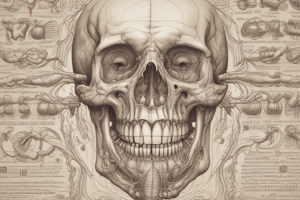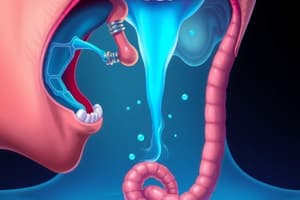Podcast
Questions and Answers
What is the primary role of gastrin in the digestive process?
What is the primary role of gastrin in the digestive process?
- To begin the process of chemical digestion in the mouth
- To stimulate the secretion of bile
- To emulsify fat in the intestines
- To signal the stomach to produce digestive hormones and acids (correct)
Which enzymes are released by the pancreas into the duodenum for digestion?
Which enzymes are released by the pancreas into the duodenum for digestion?
- Amylases and proteases only
- Amylases, proteases, and lipases (correct)
- Lipases and bile salts only
- Pepsin and hydrochloric acid
Where does most of the chemical digestion occur in the digestive system?
Where does most of the chemical digestion occur in the digestive system?
- In the mouth
- In the small intestine (correct)
- In the stomach
- In the colon
What triggers the stomach to release gastrin?
What triggers the stomach to release gastrin?
What is the main function of hydrochloric acid in the stomach?
What is the main function of hydrochloric acid in the stomach?
What is the primary function of hydrochloric acid in the stomach?
What is the primary function of hydrochloric acid in the stomach?
Which substance is responsible for digesting proteins into amino acids?
Which substance is responsible for digesting proteins into amino acids?
What role does mucus play in the digestive system?
What role does mucus play in the digestive system?
During the digestion process, what is the function of bile?
During the digestion process, what is the function of bile?
What is the purpose of conducting the 'Material Digestion' activity in class?
What is the purpose of conducting the 'Material Digestion' activity in class?
Flashcards
Mechanical Digestion
Mechanical Digestion
Physical breakdown of food via chewing, churning & segmentation.
Chemical Digestion
Chemical Digestion
Use of enzymes to break down food molecules.
Gastrin
Gastrin
Hormone that stimulates the stomach to produce digestive components.
Hydrochloric Acid (HCl)
Hydrochloric Acid (HCl)
Signup and view all the flashcards
Pepsin
Pepsin
Signup and view all the flashcards
Bile
Bile
Signup and view all the flashcards
Capillaries (in digestion)
Capillaries (in digestion)
Signup and view all the flashcards
Lacteals
Lacteals
Signup and view all the flashcards
Assimilation
Assimilation
Signup and view all the flashcards
Excretion
Excretion
Signup and view all the flashcards
Study Notes
Digestive Processes
- Mastication, churning, and segmentation are key components of mechanical digestion.
- Chemical digestion primarily occurs in the stomach and small intestines, characterized by chemical reactions that break down food.
Hormones and Enzymes
- Presence of food stimulates the release of gastrin, a hormone that increases production of pepsinogen, mucus, and hydrochloric acid in the stomach.
- Hydrochloric acid provides an acidic environment, activating pepsinogen to pepsin, which digests proteins into amino acids.
Small Intestine Function
- The majority of digestion occurs in the small intestine, particularly in the duodenum.
- Bile, released by the gallbladder and liver, emulsifies fats for easier digestion.
- Pancreatic juice contains various enzymes (amylases, proteases, lipases) that further break down carbohydrates, proteins, and fats.
Enzymes and Their Functions
- Gastrin: Signals the stomach to produce pepsinogen, mucus, and hydrochloric acid.
- Hydrochloric Acid: Creates acidic conditions that aid in digesting fiber.
- Pepsin: Enzyme responsible for breaking proteins into amino acids.
- Mucus: Protects the stomach lining from acidity.
- Bile: Important for fat emulsification.
- Pancreatic Juice: Contains enzymes that break down macromolecules into smaller units.
Nutrient Absorption
- Capillaries: Absorb water-soluble nutrients such as glucose, amino acids, vitamins, and minerals.
- Lacteals: Lymphatic vessels responsible for absorbing fatty acids and glycerol.
- The small intestine also absorbs water, minerals, and alcohol.
- The large intestine primarily absorbs water and some vitamins.
Additional Digestive Processes
- Assimilation: The process of converting absorbed nutrients into complex substances, essential for hormone and enzyme synthesis.
- Excretion: Removal of undigested materials from the body, forming feces from excess water absorption in the chyme. Feces include indigestible substances, bacteria, and mucus.
Simulation Activities
- Material Digestion Activity: Simulate mechanical and chemical digestion using simple materials like candy, crackers, sand, and water to observe different digestion methods.
- Digestion Simulation Model: Utilize mashed potatoes to represent digestion processes and structures.
Key Concepts of Digestion
- Events in the digestive system include ingestion, propulsion, digestion, absorption, assimilation, and excretion.
- Mechanical digestion involves physical breakdown while chemical digestion involves enzymatic actions.
- Digestion leads to nutrient absorption via capillaries and lacteals.
Importance of Excretion
- Excretion is crucial for eliminating undigested food, ensuring that waste products do not accumulate in the body, contributing to overall health.
Summary of Digestive Structures
- Esophagus: Responsible for peristalsis to push food to the stomach.
- Stomach: Site for gastric juice release and initiation of protein digestion.
- Small Intestine: The main area where digestion and absorption occur.
- Large Intestine: Absorbs water and vitamins; forms and expels feces.
Studying That Suits You
Use AI to generate personalized quizzes and flashcards to suit your learning preferences.



